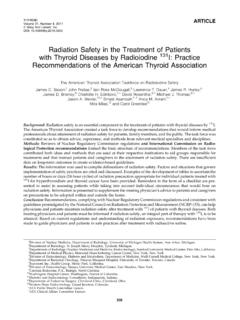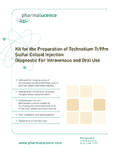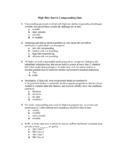Transcription of DRAFT for review - do not cite or quote - WHO
1 DRAFT for review - do not cite or quote 1 2 3 4 5 6 7 8 9 10 11 12 13 14 15 16 17 18 19 20 21 22 23 24 25 26 27 28 29 30 31 32 33 34 35 IPCS EVALUATION OF ANTIDOTES FOR POISONING BY METALS AND METALLOIDS Pentetic acid (diethylenetriaminepentaacetic acid, DTPA; calcium trisodium pentetate, Ca-DTPA; zinc trisodium pentetate, Zn-DTPA) Initial DRAFT by Jekat, Kemper & Weischer, 1995 Updated by N Bates, Guy's & St Thomas' Poisons Unit, London, UK, October 2008 DRAFT for review - do not cite or quote 236 37 38 39 40 41 42 43 44 45 46 47 48 49 50 51 52 53 54 55 56 57 58 59 60 61 62 63 64 65 66 67 68 69 70 71 72 73 74 75 76 77 78 79 80 81 82 83 84 85 86 1 Introduction Pentetic acid (diethylenetriaminepentaacetic acid, DTPA) was first synthesized in 1954 (Durbin et al., 1998). It is a polyaminopolycarboxylic acid chelator, like ethylenediamine tetraacetic acid (EDTA) and its salts ( sodium calcium edetate).
2 Pentetic acid is used as the calcium or zinc trisodium salt which acts by exchanging calcium or zinc ions for a metal with a higher binding capacity. The salts have been used in Europe and the USA (M n trier et al., 2005) as chelating agents for heavy metals and as decorporation agents for radionuclides. They are used most commonly to enhance elimination of radioactive metals following radiological accidents and are now approved by the United States Food and Drug Administration (FDA) as pharmacological countermeasures to potential radiological release or nuclear detonation including exposure from a Radiation Dispersal Device (RDD), more commonly termed a dirty bomb. Pentetic acid salts have FDA approval for use in plutonium, curium and americium exposure by inhalation, dermal and wound exposure.
3 They may also be effective for enhancing elimination of other transuranium elements such as berkelium or californium but data are limited. Pentetic acid salts are effective for enhancing elimination of cerium and zinc. Pentetic acids salts may be useful for enhancing removal of cobalt, einsteinium, lanthanum, nickel, promethium, scandium, strontium, ytterbium and yttrium but data are lacking and most of the data is from animal studies. Furthermore, the pattern and natural history of toxicity with most of these metals in humans is not well described and so the role of chelation with pentetic acid salts is difficult to determine. Cadmium chelation remains a problem and pentetic acid salts have shown limited benefit in animal studies, particularly in the more clinically relevant delayed administration studies. Pentetic acid salts are not effective in removing antimony, beryllium, bismuth, gallium, lead, mercury, neptunium, niobium, platinium, polonium, thorium and uranium.
4 Pentetic acid is not useful for radioactive iodine (Hameln Pharmaceuticals, 2004). The effectiveness of pentetic acid salts for radium or calcium has not been determined. Although pentetic acid salts have been shown to increase elimination of manganese in both animals studies and a human case report it did not prevent manganese-induced Parkinson s disease in a human case (Holzgraefe et al., 1986). Pentetic acid salts can mobilise iron and vanadium but more effective chelating agents are available. In many studies early dosing with calcium trisodium pentetate is more effective than zinc trisodium pentetate but there is no difference in efficacy between the salts when given later. For most metals pentetic acid is relatively ineffective in mobilising metal from bone and is most effective when given soon after exposure when the metal is still in the circulation or soft tissues.
5 Administration of pentetic acid salts (orally or parenterally) following ingestion of metals or radionuclides is not recommended as this is thought to increase gastrointestinal absorption. Puchel, the lipophilic derivative of pentetic acid, although effective in removing some metals, is more toxic than calcium and zinc pentetate and it is not used in humans. Pentetic acid, both as the calcium or zinc trisodium salt, is well tolerated but both salts also chelate essential trace elements and so these should be monitored in patients receiving repeated or long-term dosing with these agents. In addition to its use as an antidote, pentetic acid is commonly used in medicine as a carrier for contrast DRAFT for review - do not cite or quote 387 88 89 90 91 92 media such as gadolinium and radiopharmaceuticals such as indium-111 and technetium-99.
6 These are not discussed here. 2 Names and Chemical Formulae International non-proprietary name pentetic acid Synonyms diethylenetriamine-NNN N N -penta-acetic acid, N,N-bis[2-[bis(carboxymethyl)amino]ethyl ]glycine, pentacarboxymethyl diethylenetriamine, acidum penteticum, acide pen tique, cido pent tico, diethylene triamine pentaacetic acid, DTPA IUPAC name [[(Carboxymethyl)imino]bis(ethylenenitri lo)]-tetra-acetic acid CAS No 67-43-6 Chemical formula C14H23O10 Relative molecular mass 93 International non-proprietary name Calcium trisodium pentetate Zinc trisodium pentetate Synonyms Ca-DTPA, [N,N bis[2-[bis(carboxymethyl) amino]ethyl]glycinato(5-)calciate(3-)] trisodium, sodium[[[carboxymethyl)imino]bis (ethylenenitrilo)]tetracetato]-calcinate , [[(carboxymethyl)imino]bis(ethyelenitril o)] tetraacetic acid calcium complex trisodium salt, trisodium calcium diethylenetriamine pentaacetate,, calcii trinatrii pentetas, calcium trisodium DTPA, pentetate calcium trisodium, pent tate de calcium trisodique, pentetato calcio y trisodi Zn-DTPA, pent tate de zinc trisodique, pentetate zinc trisodium, pentetato zinc y trisodio, trisodium zinc diethylenetramine pentaacetate, zinci trinatrii pentetas, zinc pentetate, zinc trisodium pentetate IUPAC name CAS No 12111-24-9 65229-17-6 (zinc pentetate) 125833-02-5 (zinc trisodium pentetate) Chemical formula C14H18 CaN3Na3O10C14H18N3Na3O10Zn Relative molecular mass 94 95 96 97 98 99 Commercial Names.
7 Ditripentat-Heyl (Heyl, Germany), Pentetate zinc trisodium injection and Pentetate calcium trisodium injection (Hameln, Germany) DRAFT for review - do not cite or quote 4100 101 102 Conversion factors Calcium trisodium pentetate Zinc trisodium pentetate 1 g mmol mmol 1 mg mol mol 1 mmol mg mg 1 mol g g 103 104 105 106 107 108 109 110 111 112 113 114 115 116 117 118 119 120 121 122 123 124 125 126 127 128 129 130 131 132 133 134 135 136 137 138 139 140 141 142 143 144 145 Analytical grade pentetic acid is available from several manufacturers. 3 Physico-chemical Properties Physical condition: crystalline Colour: not known Melting point: 219-220 oC Boiling point: not known Solubility Readily soluble in water and alkalis.
8 Not readily soluble in ethanol or apolar solvents Optical properties: not known Acidity: not known pKa: not known Stability in light: No specific advice with respect to storage is necessary Thermal stability: stable Refractive index and not applicable Specific gravity: Loss of weight on drying: not known Excipients and pharmaceu- not known tical aids: Pharmaceutical None known incompatibilities: 4 Pharmaceutical Formulation and Synthesis Routes of Synthesis DRAFT for review - do not cite or quote 5146 147 148 149 150 151 152 153 154 155 156 157 158 159 160 161 162 163 164 165 166 167 168 169 170 171 172 173 174 175 176 177 178 179 180 181 182 183 184 185 186 187 188 189 190 191 192 193 194 195 196 Calcium trisodium pentetate can be made by mixing pentetic acid with sodium hydroxide and calcium chloride or calcium carbonate.
9 Zinc trisodium pentetate can be made by mixing pentetic acid with sodium hydroxide and zinc oxide or zinc chloride. Manufacturing Process Not known. Presentation and Formulation Pentetate zinc trisodium injection and pentetate calcium trisodium injection are available from Hameln Pharmaceuticals GmbH, Germany. Each salt is available as a 5 mL ampoule containing 200 mg in boxes of 5 ampoules. These products are available for inhalation or injection. Ditripentat-Heyl is available from Heyl Chemisch-pharmazeutische Fabrik GmbH & Co., Germany. Each 5 mL ampoule contains 1 g of calcium trisodium pentetate and it is available in boxes of 5 ampoules of intravenous injection or infusion. 5 Analytical Methods Quality Control Procedures for the Antidote Not known. Methods for Identification of the Antidote Not known.
10 Methods for Identification of the Antidote in Biological Samples Not known. Analysis of the Toxic Agent in Biological Samples Heavy metals should be analysed in blood and urine before, during and after antidotal therapy. Sensitive methods, such as atomic absorption spectroscopy (AAS) or inductively coupled plasma-atomic emission spectroscopy (ICP-AES), can be used (Berman, 1980; Bertram, 1983). Specialist advice is essential for dose assessment following a radiation accident as this assists in determining appropriate management and the expected clinical course. Radioactivity measurements of the wound (if applicable), skin or chest (following inhalation), nasal swabs, urine and faeces are also used to assess dose. In many cases the victim is not wearing a dosimeter (and this only measures external exposure not the internal dose).














